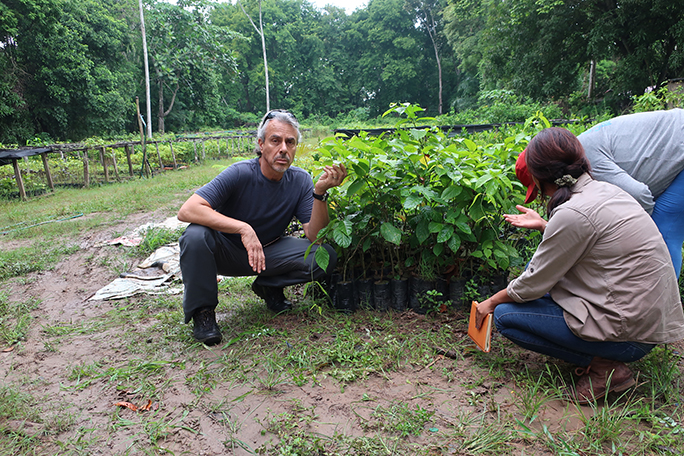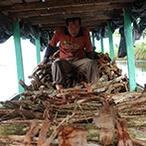Chris Kilham at Vivero Ucayali Rainforest with four-month-old ayahuasca seedlings
First Published online on American Botanical Council HerbalEGram March 15, 2018
Introduction
Over the past several years, members of ayahuasca groups and various social media sites have referred to the supply of ayahuasca vine (Banisteriopsis caapi, Malpighiaceae) in Peru as imperiled and environmentally devastated. And yet, the largest ayahuasca retreat centers in Iquitos (Loreto region) and Pucallpa (Ucayali region) appear well supplied with this vine. I have seen cultivation of this vine in at least a dozen locations in both geographic regions, inspected large shipments of ayahuasca at some of the higher-volume ayahuasca healing centers, and observed that the supply of vine has thus far been sufficient for the current levels of demand. That said, my observations cannot be construed as definitive.
Ayahuasca, a psychedelic brew typically made from the ayahuasca vine and leaf of chakruna (Psychotria viridis, Rubiaceae) or sometimes huambisa (Diplopterys cabrerana, Malpighiaceae), is now highly popular in these areas of Peru as well as in other areas of the Amazon in Brazil and other South American locales. It also is brewed and bottled for export for increasingly popular ceremonial use in the United States and elsewhere.
In the Iquitos area alone, there are approximately 120 ayahuasca centers that largely cater to foreign pasajeros (passengers), according to Iquitos guide Juan Maldonado. While the leaves of chakruna and huambisa grow on bushes that can be ready for harvest in two or three years, the ayahuasca vine takes a minimum of five years to mature. According to numerous people with whom I have spoken since 2006, the main supply issue concerns the future wild populations of ayahuasca.
To determine supply, I conducted a multi-site field assessment in the Peruvian Amazon. The first trip took place in January 2018, in both the Pucallpa and Iquitos regions. To understand the state of supply and cultivation, I traveled around Pucallpa with Sergio Cam of Chakarunas Trading Company, visiting growing sites and speaking with people mostly of Shipibo native origin, who are involved in ayahuasca supply. Cam and I have trRaveled throughout Amazonia and the Andes for 20 years and investigated a broad range of medicinal plants during that period. Pucallpa is the home of the majority of Shipibo natives, who feature prominently in ayahuasca shamanism and supply.
After our time in Pucallpa, I traveled to Iquitos to visit growers and interview people from various ayahuasca retreat centers about the supply of ayahuasca vine. I was aided by Juan Maldonado, a well-established guide in the region. I have known Maldonado for more than 10 years, and previously have relied on him for information, supply of hard-to-obtain plants, and assistance visiting some villages in the region.
Because ayahuasca is also popular in Brazil, Colombia, Ecuador, Costa Rica, Hawaii, and other tropical locales, my field research in the Pucallpa and Iquitos regions cannot provide definitive information about the supply of vine throughout the entire ayahuasca scene. However, my initial assessment has provided valuable insight into the status of ayahuasca cultivation and supply in two of the most heavily trafficked areas for ayahuasca ceremonies. To monitor the ayahuasca supply further will require subsequent trips to the Amazon, to visit places not covered on this first field mission.
For the purposes of simplicity, “ayahuasca” will be used hereafter in this report to refer to Banisteriopsis caapi, the ayahuasca vine, and not the ritual brew of which it is a primary ingredient. Among local and native people in Peru, this is common parlance.
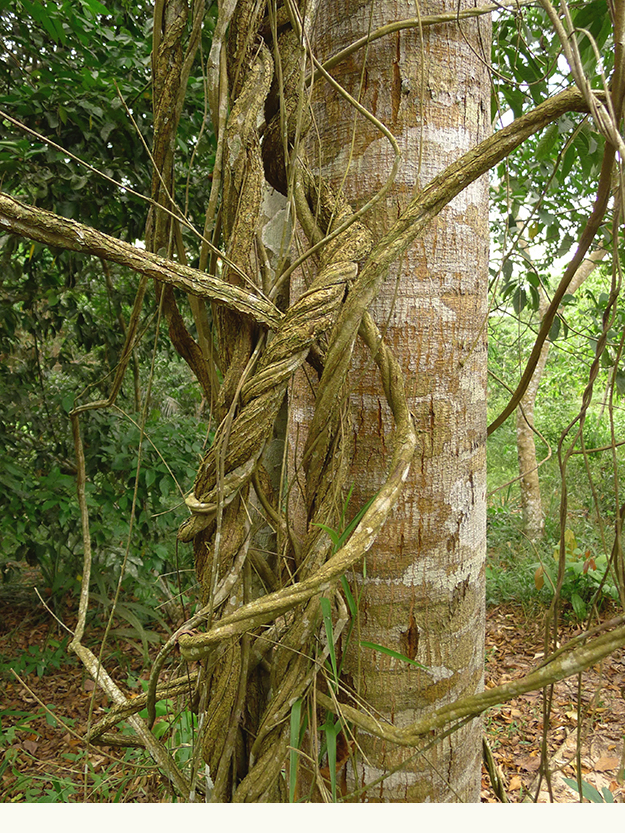
Ayahuasca (Banisteriopsis caapi) vine
Pucallpa, Ucayali Region
Notes from conversation with shaman Wiler Noriega from the village of Limongema, about an hour by boat south up the Ucayali River from Pucallpa:
According to Noriega, he and his son have planted both B. caapi and P. viridis extensively on five hectares of land near Limongema, with the intention to plant much more. They accomplished this by planting sections of main vine, or vine branches, in soil. Noriega claims that he has planted approximately 3,000 vines, but does not know the exact number in the ground. The vines will not be ready to harvest for at least four years.
Noriega informed us that for several years he has acquired ayahuasca from brokers. Those who supply the vine come from the Pucallpa region, aggregating collections from harvesters who cut wild forest populations along the Rio Tamaya. This river runs east from the Rio Ucayali just south of Pucallpa, toward the Brazilian border in Acre province.
Currently, Noriega pays 150 Peruvian nuevo soles (approx. $46 USD) per 25-30-kilogram sack of dried ayahuasca vine. By his recipe, he will get one to two liters of brew from each sack of vine, and will use approximately five kilograms of chakruna for the same batch. He was introduced to ayahuasca suppliers through friends, and said that if he orders ayahuasca, he receives the shipment in about 15 days. Noriega has been told that gathering ayahuasca has become more challenging, as harvesters need to venture further into the forest to harvest. Vines are typically cut in a sustainable manner, with the roots remaining in the ground, which allows the plant to regenerate over time.
Prepared ayahuasca brew is currently being shipped (in general, illegally; see “Ayahuasca Legality” sidebar) in liquid form to the United States and other foreign countries for approximately $400 per liter. Noriega told us that in Peru, the same prepared ayahuasca brew sells for approximately $100 per liter. In Peru, ayahuasca plants and brew are legal, and the medicine is revered as part of the country’s “national patrimony.”
Noriega also gave us a tip on a place called Tupac off of kilometer 15 in Pucallpa, where he says ayahuasca is being cultivated.
Noriega informed us that the best brew comes from freshly harvested ayahuasca vine that is still juicy. The drier the vine, the poorer the quality of the brew. He also claimed that ayahuasca is superior in quality when grown on higher ground.
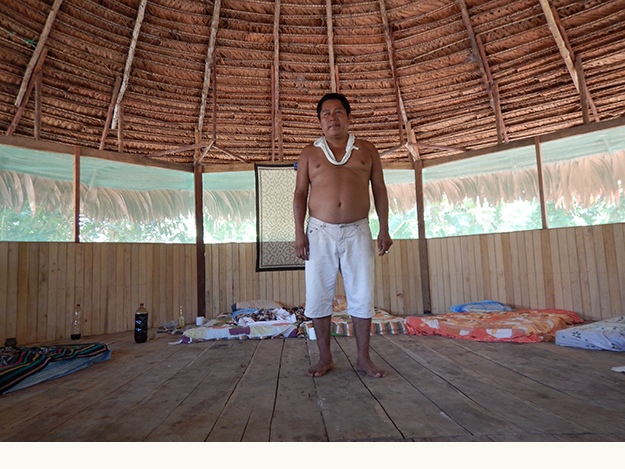
Wiler Noriega, a shaman in the village of Limongema
Notes from boat captain Heime Baca, with whom I have traveled on several rivers in the Ucayali and Loreto regions: Baca informed me that a forestry engineer has planted approximately 2,500 ayahuasca vines near the Brazilian border, somewhere along the Rio Tamaya. Through Baca, Cam and I were introduced to Jimmy Rojas, who makes large quantities of ayahuasca on a regular basis. We were taken to the Manantai neighborhood where Rojas lives and cooks his brew.
Notes from a visit with Jimmy Rojas Minos, in the Manantai region of Pucallpa:
Rojas comes from Utucuro, a Shipibo village in the Ucayali region, where he was both a shaman and a chief. He learned his craft from his grandfather, Vicente Sanchez, and decided to leave his village for greater opportunities in the Pucallpa area. He has been cooking ayahuasca for several years, and supports his family with this activity.
Every month, Rojas makes 30-40 liters of ayahuasca, which he sells to two customers, Kush and Eric, who run healing centers in the Cuzco area. His recipe consists of 30 kg of ayahuasca vine and 12 kg of chakruna leaves per liter of finished brew. He pays 80 nuevo soles ($24.61) per 30-kg sack of ayahuasca, which he obtains from two sources: one is a day upriver south on the Rio Ucayali, and the other is along the Rio Tamaya. Rojas sells his ayahuasca for 150 nuevo soles ($45.97) per liter.
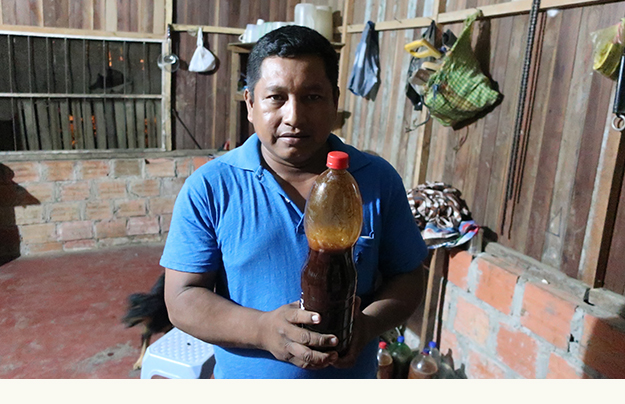
Jimmy Rojas, an ayahuasca brewer
Notes from a visit to Vivero Ucayali Rainforest, a supplier of seedlings of medicinal plants, fruit trees, and ornamental plants in Pucallpa: According to the son of the recently deceased founder of Vivero Ucayali Rainforest, ayahuasca is becoming increasingly popular, and sales of seedlings are up. He was not able to disclose quantities being sold, but insisted that there has been a steady increase in popularity of the vine. Each seedling sells for 5 nuevo soles ($1.55). The seedlings we saw were four months old.
Notes from a visit to the Ministry Of Agriculture in Pucallpa: We met briefly with Raoul, an officer of the ministry. We asked if the ministry was engaged in any kind of assessment of ayahuasca populations or sustainability. Raoul told us that at present there are no such programs or plans for any programs focusing on ayahuasca.
Notes from a visit to Los Cielos Amazonian Healing Retreat Center: Cam and I traveled approximately two hours with a driver named Gilmer from Pucallpa to Los Cielos, south of the city. There we were met by Sylvie Meier, who runs the center. (Her name “Sylvie,” from the Latin silva for forest, seems perfect for her profession and geographical situation.) At the time of our arrival, they were cooking 100 kg of vine and 125 kg of chakruna to make approximately 10 liters of ayahuasca brew.
According to Meier, the center pays about 900 nuevo soles (approx. $277) for 100 kg of ayahuasca, and approximately 800 nuevo soles (approx. $246) for 125 kg of chakruna. Since its inception, the center has purchased ayahuasca from dealers who aggregate collections from the Rio Tamaya. In 2017, the center planted 250 ayahuasca vines, and Meier said they intend to plant more. The center also uses some shade-grown chakruna cultivated near Pucallpa.
Ayahuasca is prepared every two to three months at Los Cielos in an elaborate and lengthy process that takes 11-12 days from start to finish. The center employs strict standards of cleaning, washing, straining, and preparation, making theirs the most elaborate ayahuasca preparation I have witnessed. The resulting brew made from this prepared vine is clean, thick, dark, and sweet, with a tolerable flavor that is uncommon to ayahuasca.
Meier gave us a tour of the property at Los Cielos, where dozens of species of native medicinal plants are cultivated. Though they currently obtain their ayahuasca from dealers, they hope in time to be self-sustaining.
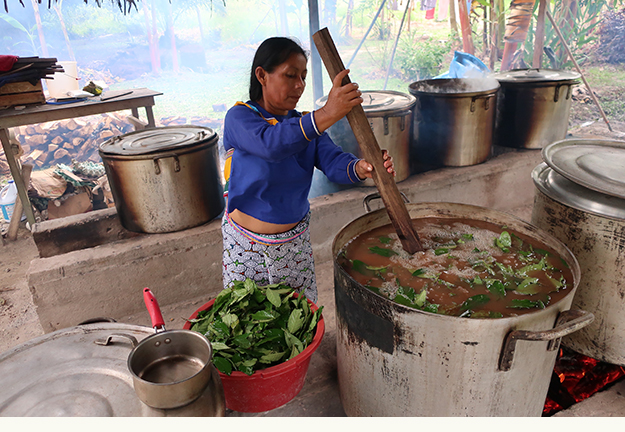
A woman making ayahuasca at Los Cielos
Iquitos, Loreto Region
Notes from a visit with Elizabeth Bardales Rengifo of Natural Chacruna Productos Naturales: In the company of Juan Maldonado, I visited Bardales, whose 15-year-old business Natural Chacruna is well-known in the Iquitos area. An agronomic engineer, Bardales runs an impressive herbal processing and manufacturing business including solar drying, grinding, milling, sanitizing, cooking, evaporating, package labeling, and sales. Her business is completely unmarked on the outside, yet is expansive and large inside.
Bardales makes “bricks” of ayahuasca, which are solid blocks of cooked ayahuasca that have been dehydrated. In commercial extraction, this product is referred to as a native extract. The bricks take up relatively little space compared with the liquid ayahuasca brew, and are appreciably easier to ship. She did not say how much ayahuasca vine she uses on a monthly basis, but did share that the ayahuasca comes from the Rio Tamaya. Her recipe of 25 kg of ayahuasca and 7 kg of chakruna also contains smaller amounts of ajo sacha (Mansoa alliacea, Bignoniaceae), mapacho (Nicotiana rustica, Solanaceae), and Ilex guayusa (Aquifoliaceae), and makes 1 kg of finished solid brick. A single brick, when re-constituted, will yield 10 liters of liquid ayahuasca brew.
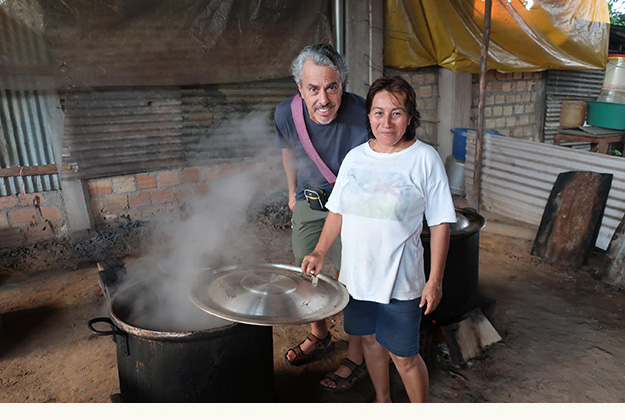
The author with Elizabeth Bardales Rengifo at Natural Chacruna
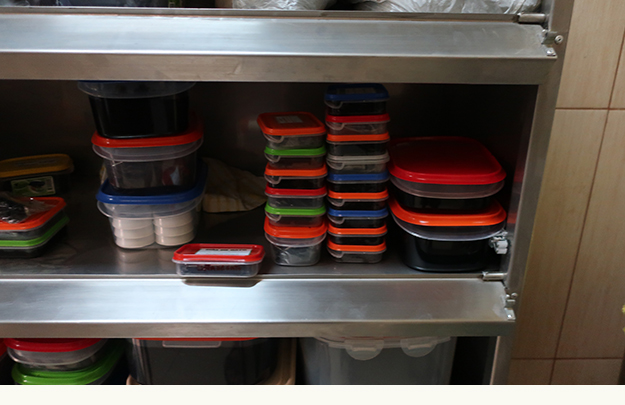
“Bricks” of ayahuasca at Natural Chacruna Productos
Notes from a visit to Francisco Montes, kilometer 18 on the Nauta Road south of Iquitos: Maldonado and I visited Francisco Montes at his Sacha Mama Lodge. Montes has been a respected curandero in the Iquitos area for 35 years. His ayahuasca retreat center lies some distance away from the Nauta Road, behind his Sacha Mama Lodge, which has an herbal bar and a visionary art gallery.
Montes has the most ambitious ayahuasca cultivation I have encountered so far. He has planted more than 6,000 vines on his property, and some are more than 15 years old. In fact, he has so much ayahuasca that he uses the dried vines for handrails on stairs, railings around porches, and as decorations inside and outside the many buildings on his property. Montes does not purchase ayahuasca, as the amount he grows is far more than sufficient for his needs. Montes currently grows 3,000 DMT-containing huambisa plants on his property instead of chakruna, because he prefers the somewhat stronger visionary effect of the huambisa. As a result of this cultivation, Montes is self-sufficient.
Montes appears to be a model in the ayahuasca scene. Cultivating vastly more than he needs, he is assured of a steady supply of ayahuasca for as long as he wishes. He provides some prepared ayahuasca to other shamans in the Iquitos area.
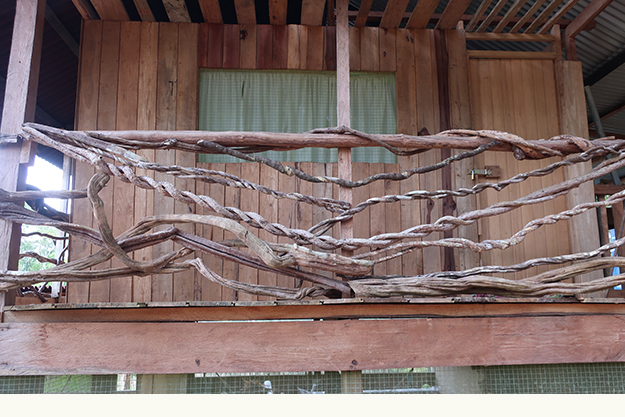
Ayahuasca vine railings at Francisco Montes’ retreat
Notes from a visit with Ron Wheelock, a “gringo shaman” popularized by a CNN special on ayahuasca hosted by Lisa Ling: Wheelock has a camp down the Nauta Road at kilometer 23 called El Purgero, but we met at his home at kilometer 9 on the Nauta Road. Shortly after we arrived, he pointed to a very large ayahuasca vine in his yard and explained that it is 20 years old, planted in 1997. According to Wheelock, just the week before our visit he had harvested 280 kilograms of material from that one vine. Looking at the massive climbing vine, it was not possible to tell that so much material had been taken.
Until two years ago, Wheelock had regularly purchased ayahuasca. But he currently has enough mature vines to supply the needs of his camp and the pasajeros who visit. Wheelock estimates that he currently has approximately five tons of mature vine on his home property, and that the five tons of vine will yield 1,000 liters of ayahuasca brew, which he sells for $250 per liter.
The recipe that Wheelock follows for making ayahuasca brew is 40 kg of ayahuasca and 5 kg of huambisa per pot, yielding 6-8 liters of finished brew.
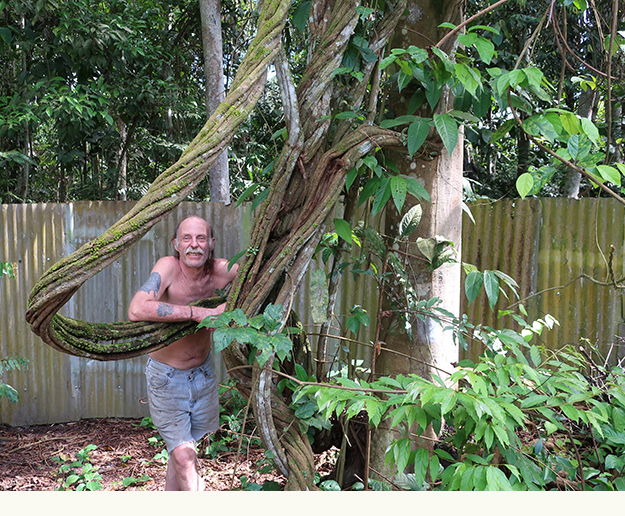
Ron Wheelock with 20-year-old ayahuasca
Notes from a visit with Julio Siri, curandero in San Rafael, about 45 minutes up the Amazon River from Iquitos: A village shaman, Siri has approximately 50 vines growing on his property, and some are 15 years old. He said that the vine needs to grow for at least five years prior to use, and that younger vines yield a diminished effect.
Siri does not purchase ayahuasca, and grows his own chakruna for ayahuasca brew. He offers ceremonies to those who seek his guidance, and does not run a typical ayahuasca retreat. Ceremonies are held on the porch of his house. He said that he makes a fresh batch of brew once the last batch is gone, however long that takes.
Siri’s recipe for ayahuasca is 5 kg of vine and 1 kg of chakruna to yield one liter of brew.
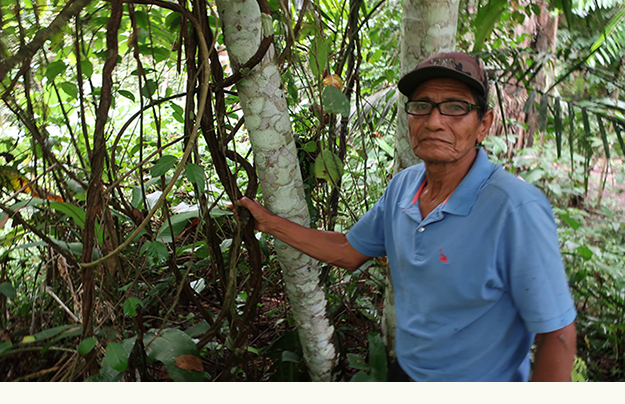
Julio Siri with ayahuasca
Notes from a conversation with Carlos Tanner of the Ayahuasca Foundation, which runs three ayahuasca retreat centers: Ayahuasca Foundation has three curanderos making ayahuasca. Tanner estimates his current purchases of ayahuasca at around 10-13 sacks per month, approximately 25-30 kg per sack, at a cost of 150 nuevo soles per sack.
Staff members at the centers started planting ayahuasca eight years ago. Currently the centers have over 300 vines. Plus, every program participant at Ayahuasca Foundation plants a vine. This is now standard practice. Tanner intends to get to the point that Ayahuasca Foundation can rely on their own vines for ayahausca.
Tanner says that he has never experienced difficulty obtaining ayahuasca. “People understand when there is a market for something,” he explained.
Tanner informed me that shaman Don Lucio of Kapitari on the Rio Nanay has over 1,000 cultivated vines.
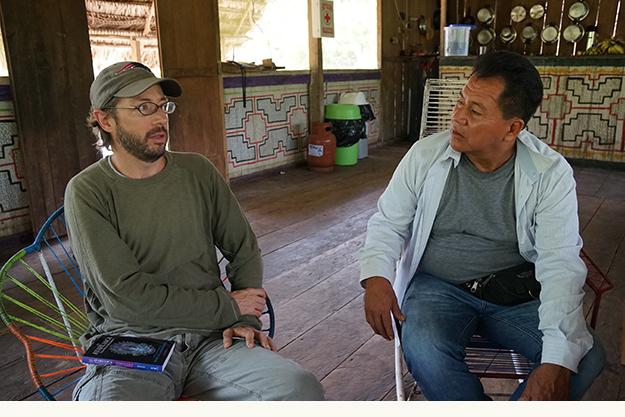
Carlos Tanner and shaman Enrique at the Ayahuasca Foundation
Correspondence from Matthew Watherston, founder of Temple of the Way of Light:
“This subject is of course an important and ongoing conversation and significant focus for us at the Temple! I shared with you last year our plans redeveloping sustainable ayahuasca plantations in local villages and our intention to establish a new initiative called “Ayni Ayahuasca.” This project is still in development although will be launched later this year.
Just around the Temple, we now have over 1,000 vines growing and various different areas with chakruna plants. However, our main interest is to support local communities to grow vine and to generate income over the long term. The plan is to do this through successional poly-cropping i.e., regenerating degraded/slash-and-burnt lands through planting fast-, medium-, and slow-growing plants/trees with ayahuasca planted initially to grow up fast-growing trees and then move onto slower growing trees. Therefore generating yields over 10 years from different plants in the short, medium and long term with main goal being reforestation with ayahuasca growing throughout.
We actually do have issues with the supply of vine (not leaf) which we source from the Ucayali, and we are finding that it is becoming harder and harder to source and more and more expensive…. And I hear the same for other centers too.”
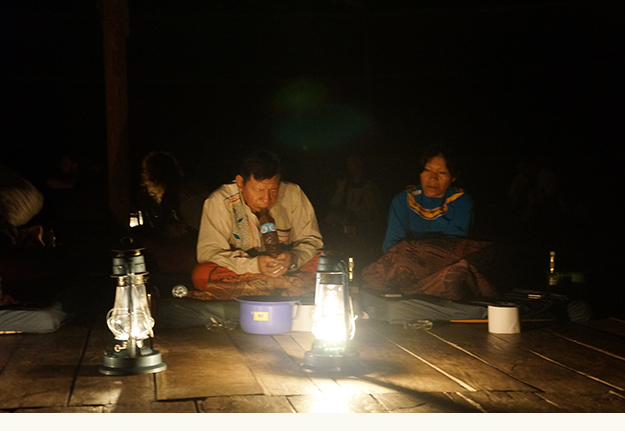
Ayahuasca ceremony at the Temple of the Way of Light
Conclusions
The prepared brew ayahuasca is illegal to purchase, sell, prepare, dispense, or transport in the United States. Two churches, Santo Daime and Unãio de Vegetal, enjoy limited protected status to employ ayahuasca as a sacrament in their church services.
Ayahuasca vine is legal to purchase, sell, prepare, dispense, or transport, but chakruna and huambisa are not legal due to their DMT content. Any shipping of prepared ayahuasca into the United States, outside of the two designated churches above, is against international drug trafficking laws.
Based on the people with whom I spoke, it appears that the Rio Tamaya region is a primary area for forest harvesting of ayahuasca. Comments about availability of vine are mixed, with some people expressing that harvesting is becoming more challenging, and others claiming no difficulty obtaining vine. At this time, there appears to be no crisis with regard to supply.
Cultivation of ayahuasca is very much on people’s minds, both from a sustainability standpoint and from a cost perspective. Cultivation of ayahuasca assures sustainability, and also offers full traceability of materials. These are great advantages. Additionally, there is a sense among many that ayahuasca, even if it is relatively plentiful in the Rio Tamaya area, will sooner or later become endangered if cultivation efforts are not widely initiated.
As I described at the onset of this report, this is in no way a full and complete examination of ayahuasca harvesting and cultivation in Loreto and Ucayali regions. Rather, it is an approximation, a snapshot, assembled thanks to the help of a great many people. An obvious next effort will be to travel the Rio Tamaya, to speak with collectors there, and to document forest harvesting of ayahuasca.
I especially wish to thank Sergio Cam of Chakarunas Trading Company and guide Juan Maldonado for their kind assistance. I could not have conducted this survey without them. I also wish to thank every person who allowed me to interview and photograph them for this report.
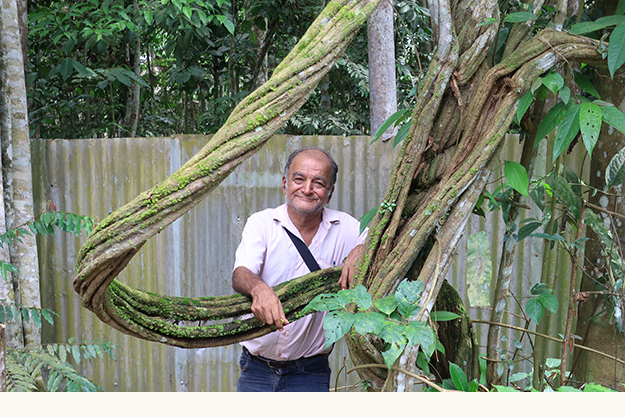
Juan Maldonado with ayahuasca vine
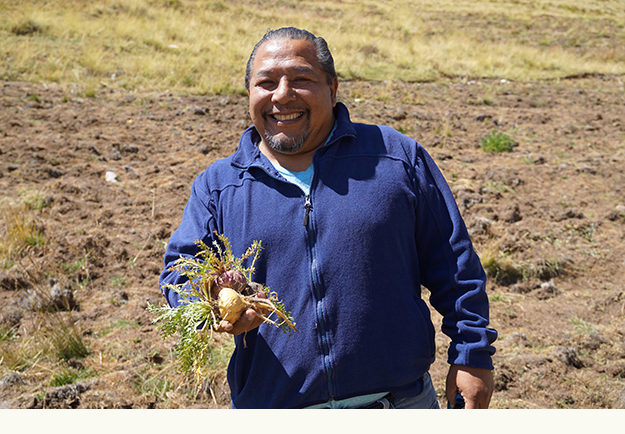
Sergio Cam, with Maca in the Peruvian Andes
Chris Kilham is a medicine hunter, author, and educator. He has conducted medicinal plant research in more than 40 countries, is the author of 15 books, and has appeared on hundreds of TV programs globally. CNN calls Chris “The Indiana Jones of Natural Medicine.” More information is available at www.MedicineHunter.com.
All photos by Chris Kilham


